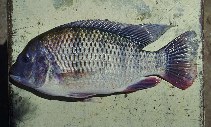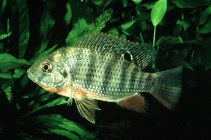Colombia country information
Common names:
[No common name]
Occurrence: introduced
Salinity: freshwater
Abundance: | Ref:
Importance: | Ref:
Aquaculture: commercial | Ref:
Regulations: | Ref:
Uses: no uses
Comments:
National Checklist:
Country Information: https://www.cia.gov/library/publications/resources/the-world-factbook/geos/co.html
National Fisheries Authority:
Occurrences: Occurrences Point map
Main Ref: FAO, 1996
National Database:
Occurrence: introduced
Salinity: freshwater
Abundance: | Ref:
Importance: | Ref:
Aquaculture: commercial | Ref:
Regulations: | Ref:
Uses: no uses
Comments:
National Checklist:
Country Information: https://www.cia.gov/library/publications/resources/the-world-factbook/geos/co.html
National Fisheries Authority:
Occurrences: Occurrences Point map
Main Ref: FAO, 1996
National Database:
Common names from other countries
分類 / Names 共通名の | 類義語 | Catalog of Fishes(部類, 種) | ITIS | CoL | WoRMS | Cloffa
> Cichliformes (Cichlids, convict blennies) > Cichlidae (Cichlids) > Pseudocrenilabrinae
Eponymy: Dr Percy Rendall (1861–1948) was a medical practitioner and itinerant naturalist who collected over much of Africa and in Trinidad and other Caribbean locations in the late 19th century. [...] (Ref. 128868), visit book page.
More on author: Boulenger.
Eponymy: Dr Percy Rendall (1861–1948) was a medical practitioner and itinerant naturalist who collected over much of Africa and in Trinidad and other Caribbean locations in the late 19th century. [...] (Ref. 128868), visit book page.
More on author: Boulenger.
Environment: milieu / climate zone / depth range / distribution range 生態学
分布 国々 | 国連食糧農業機関の区域 | エコシステム | 事件 | Point map | 導入 | Faunafri
Africa: from the middle Congo River basin (Kasai drainage and between the Lomami and Kisangani) up to the upper Lualaba and the Bangweulu area (Ref. 55074). Also in Lake Malawi, Zambesi, coastal areas from Zambesi Delta to Natal, Okavango and Cunene (Ref. 5163) as well as the Limpopo, Malagarasi (Ref. 55074) and Lake Tanganyika (Ref. 55074, 74387). Also present in the Cuanza and Catumbela rivers in Angola (Ref. 11970). Introduced in Lake Kivu, escaped from fish ponds (Ref. 107916). Introduced elsewhere usually for weed control and aquaculture. Several countries report adverse ecological impact after introduction.
Length at first maturity / サイズ / 重さ / 年齢
Maturity: Lm 17.7 range ? - ? cm
Max length : 45.0 cm TL オス/雌雄の選別がない; (Ref. 26550); 最大公表体重: 2.5 kg (Ref. 26550); 最大記録サイズ: 7 年 (Ref. 7248)
Max length : 45.0 cm TL オス/雌雄の選別がない; (Ref. 26550); 最大公表体重: 2.5 kg (Ref. 26550); 最大記録サイズ: 7 年 (Ref. 7248)
簡単な記述 検索表 | 形態学 | 形態計測学
背面の脊椎 (合計) : 15 - 17; 背鰭 (合計) : 10 - 13; 肛門の骨: 3; 臀鰭: 9 - 10; 脊つい: 29. Diagnosis: A large, deep-bodied species with a steep head profile, narrow head and small mouth; often appearing brownish with a white belly, some individuals have bright red bellies (Ref. 118638). The sexes look very similar, although males are usually larger (Ref. 118638). Very difficult to distinguish from Coptodon zillii, but C. rendalli usually have a steeper head profile and less prominent vertical bars; in East Africa, the tailfin of C. rendalli is often divided into a brownish upper part and yellowish lower part, whereas that of C. zillii is uniform and spotted (Ref. 118638).
It prefers quiet, well-vegetated water along river littorals or backwaters, floodplains and swamps. They are tolerant of a wide range of temperatures (8-41°C) and salinities (Ref. 3, 7248, 118638). Forms schools; is mainly diurnal. Juveniles feed on plankton (Ref. 52307); adults feed on leaves and stems of underwater plants as well as algae, and vegetative detritus (Ref. 52307), insects and crustaceans. A substrate spawner; male and female form pairs to rear the young; eggs and larvae are usually guarded in a steep-side circular pit dug in the mud (Ref. 118638). Occasionally it spawns in large cave-like structures (Ref. 52307), e.g. in Lake Malawi they are reported to dig a network of tunnels at some sites (Ref. 118638). Make excellent eating (Ref. 5214). Widely exploited in fisheries and aquaculture (Ref. 118638).
Life cycle and mating behavior 成熟 | 繁殖 | 放精 | 卵 | 生産力 | 幼生
Prefers a sloping spawning ground near the marginal fringe of vegetation (Ref. 3). Builds nest in shallow water where both parents guard the eggs and young.
主な参考文献
Upload your references | 参考文献 | コーディネーター : Kullander, Sven O. | 協力者
Dunz, A.R. and U.K. Schliewen, 2013. Molecular phylogeny and revised classification of the haplotilapiine cichlid fishes formerly referred to as "Tilapia". Mol. Phylogenet. Evol. 68(1):64-80. (Ref. 93285)
人間に対する脅威
Potential pest
Human uses
水産業: 商業; 水産養殖: 商業; ゲームフィッシュ: はい; 水族館・水槽: 商業
FAO(Aquaculture systems: 代謝; ; publication : search) | FishSource |
より多くの情報
Population dynamics
成長のパラメーター
Max. ages / sizes
Length-weight rel.
Length-length rel.
体長組成
Mass conversion
補充
豊度
成長のパラメーター
Max. ages / sizes
Length-weight rel.
Length-length rel.
体長組成
Mass conversion
補充
豊度
Physiology
Body composition
Nutrients
酸素消費
水泳形態
泳ぐ速さ
Visual pigments
Fish sound
Diseases & Parasites
Toxicity (LC50s)
Body composition
Nutrients
酸素消費
水泳形態
泳ぐ速さ
Visual pigments
Fish sound
Diseases & Parasites
Toxicity (LC50s)
用具
Bio-Quiz | E-book | 野外観察図鑑 | 検索表 | Length-frequency wizard | 生活史の基盤ツール | 目的のマップ | Classification Tree
| Catch-MSY |
特記事項
XMLをダウンロードして下さい
インターネットの情報源
Alien/Invasive Species database | Aquatic Commons | BHL | Cloffa | Websites from users | Check FishWatcher | CISTI | Catalog of Fishes(部類, 種) | DiscoverLife | ECOTOX | Faunafri | Fishtrace | GenBank(ゲノム, ヌクレオチド) | GloBI | GOBASE | | Google Books | Google Scholar | Google | IGFA World Record | MitoFish | 国のデーターベース | Otolith Atlas of Taiwan Fishes | PubMed | Reef Life Survey | Scirus | SeaLifeBase | 生命の木 | Wikipedia(行く, 検索する) | World Records Freshwater Fishing | 動物に関する記録
Estimates based on models
Phylogenetic diversity index (Ref. 82804): PD50 = 0.5000 [Uniqueness, from 0.5 = low to 2.0 = high].
Bayesian length-weight: a=0.01585 (0.01351 - 0.01859), b=3.00 (2.96 - 3.04), in cm Total Length, based on LWR estimates for this species (Ref. 93245).
栄養段階 (Ref. 69278): 2.3 ±0.1 se; based on diet studies.
回復力 (Ref. 120179): 手段, 1.4年~4.4年の倍増期間の最小個体群 (K=0.13-0.18; tmax=7).
Fishing Vulnerability (Ref. 59153): Low to moderate vulnerability (27 of 100).





